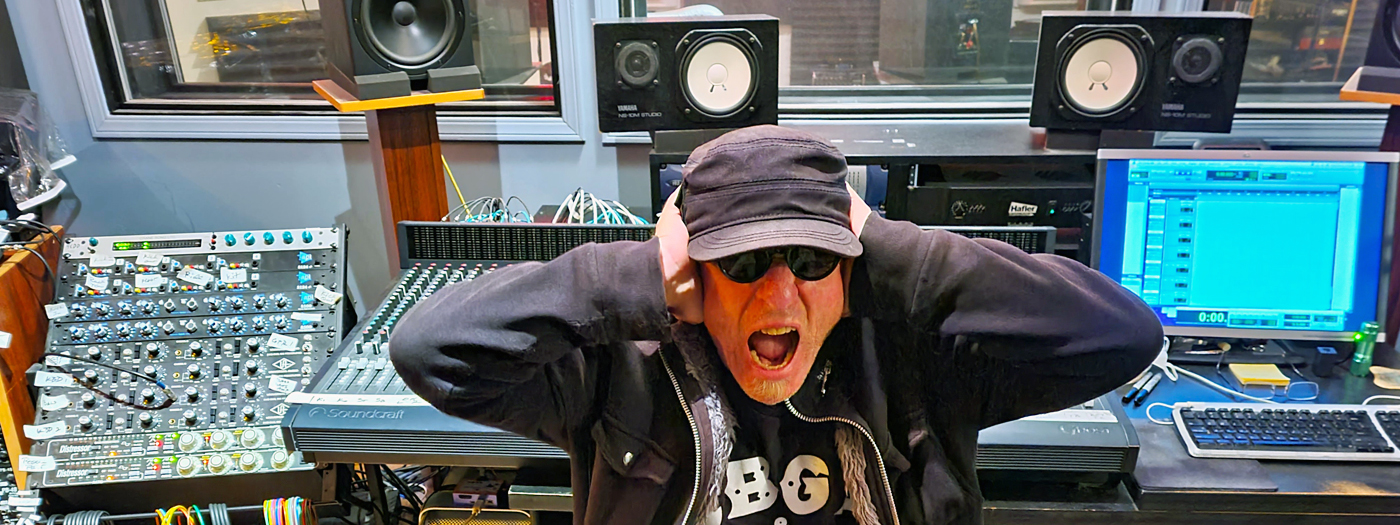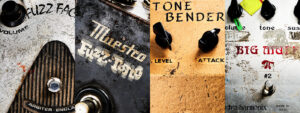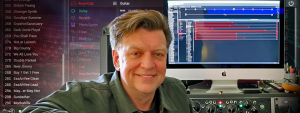Michael Molenda: Five Ways to Massacre Your Mix
by Michael Molenda
I love the “Covid can’t stop us” mantra of home-recording musicians trading audio files back and forth with collaborators to create tracks using GarageBand, Pro Tools, or one’s DAW of choice. Thanks to the ongoing march of technological advancements, we absolutely have the tools to produce songs that often stand up to tracks recorded and mixed in large commercial studio facilities. Go team!
But perhaps you are not down with home-grown excellence conjured up with portable laptops and cool software. No way. You are fighting to uphold the legacy of old-school recording media—big studios, tuned control rooms, massive analog mixers, well-stocked mic cabinets, and a platoon of video games and foosball tables assembled in the lunchroom.
Well, fear not, my lovely Luddites—here are five ways to ensure your pandemic-era home-studio collaborations go down in flames, paving the way to gleefully resurrect the recording arts circa 1972.
Have Collaborators Deploy a Potpourri of Sample Rates
This is more of a “situation” for GarageBand users, as the software operates at a fixed sample rate of 44.1kHz. Ask everyone who is contributing to your production to send their audio files in various 44.1kHz, 48kHz, and 96kHz formats. Then, don’t pay attention to any of the sample rates you’ve collected and load them all willy-nilly into your master track. The resulting sample-rate gumbo will not significantly affect audio quality, but it may cause “synch drifts” that will mess with the timing of instrumental and vocal phrasing/accents and upend your grooves. Sure, you can adjust, say, guitar tracks to line up better with your drum track, but why bother? Explore the glories of non-synchronization and let the tracks land where they will.
Jettison Microphone Technique
Sing directly—and forcefully—into the diaphragm of a condenser, ribbon, or dynamic microphone without a pop screen as a signal sentinel. Capture as many plosive (pops and “pa”) and sibilant (“sss”) sounds as you can. You can’t truly fix things such as a big ol’ pop right in the middle of a verse lyric, so don’t bother. It’s the performance that counts and your true fans will forgive disturbing and/or annoying audio gremlins if the vocal is appropriately impassioned. Even better news—you don’t have to waste time and effort soloing vocal tracks to check if the audio is clear, clean, and pristine.
Go Barking Mad with Reverb
You can never have too much of a good thing, so celebrate the glories of reverb everywhere. Slather it on vocals, background vocals, guitars, snares, and kick drums, and don’t forget to add oodles of sexy ambience to keyboard and percussion tracks. Don’t give a thought to the reality that attack, precision, clarity, edginess, and transparency have been decimated, because your magnificent waterfalls of reverb are really all you need to thrill listeners.
Squash Tracks to Hell
Just like high-intensity action flicks, impact is everything for most music tracks. You want elements to explode out of playback systems and pummel audiences with confrontational, in-your-face sonics. Crush every track with high compression settings, and leave no mix element unprocessed to float languorously around the track. You’re the sonic Marines here—not a mime troop. Attack!
Start a Cage Match with the Frequency Spectrum
Speaking of the Marines, create added drama with a pitched battle across your frequency spectrum. Add competing low-end tweaks to the kick drum, bass, keyboards, and even the guitar (you want that “warm” sound, right?). Then, devour midrange frequencies with guitars, vocals, and all kinds of chatter clatter. Don’t forget to EQ everything—preferably in the 1kHz to 5kHz range. Turn highs into a searing onslaught of shimmer by raising the levels of cymbals and other trebly bits, as well as boosting the EQ in the 10kHz and above area.
“I get one, two, or up to all five of the abominations detailed here with every single mix gig I’m offered, and the blunders always come from very smart people and talented artists.”
And here’s another little trick: Spend lots of time soloing individual tracks and making them sound marvelous in the vacuum of themselves. Who cares that all sounds in your mix have to coexist in a stereo spectrum with the other tracks? Dial in the beauties one single track at a time, and let the strong frequencies survive when all of the tracks are combined in the stereo mix.
Fun with Contradictions
Okay. We’re having a giggle here in “opposite world,” trading some basic “what not to do’s” for “what you actually should do.” But here’s the shocking truth: Every one of these ruinous sonic moves have been provided to me when I’m commissioned to do mix gigs for artists and bands. It’s not a matter of a few nutters out there, either. I get one, two, or up to all five of the abominations detailed here with every single mix gig I’m offered, and the blunders always come from very smart people and talented artists.
We can make assumptions about why the situation is the way it is. Perhaps a part of it is the usually evenhanded “open borders” approach to modern music making, where anyone can post anything on a social network, and if it finds an audience, then it’s golden. Compositional savvy, performance skills, and audio quality can be tossed out like putrid water from a vase of flowers if a less-than-conventionally wonderful production catches fire (or, better put, “legions of ears”).
But while all artists should be aware that the public decides our fate in the commercial realm—no matter how arrogant or paranoid a particular creator might be, how fabulous their recording rig is or isn’t, or the extent of one’s marketing acumen and promo budget—it certainly doesn’t hurt to elevate one’s craft and make enchanting music that also happens to sound superb. You can have it both ways!
As you commit to recording tracks in your bedroom, garage, bathroom, living room, and even garden, don’t let naivete and/or inexperience tank your process or sonic quality. Sure, you can actually get away with a lot if you are exclusively producing work by yourself. But if you need collaborators—a drummer, a guitar player, vocalists, keyboardists, percussions, or an outside mix engineer/producer like me—then making it fun, easy, and technically coherent for others to contribute to your work becomes a critical component of the production process. Here are some tips for turning this article into “Five Ways to Create Magnificent Mixes.” Have at it…

Having racks of great recording gear at your disposal doesn’t mean you should get “processing possessed” and entomb your mix in myriad textures of compression, EQ, and whatever else you can get your hands on. Use restraint, let the tracks breathe, and don’t bring on the goop solely for the sake of using a cool tool. Your song will thank you.
Sample Rates. When I use GarageBand, the main challenge I encounter with mixed sample rates and the resulting unsynchronized tracks is in nudging the tracks back to a more rhythmic context, I impose my vision of the groove and maim the performer’s interpretation of playing on, ahead, or behind the beat. Mixers play with moving stuff around all the time, but evaluating the artist’s intention before messing with anything is a good move in my book. And it’s a simple fix: Select the optimum sample rate for whatever DAW you work with and demand your collaborators send you audio files in that specified format. No muss. No fuss. Done.
Mic Technique. It drives me crazy few artists take scrupulous care of how they sing into a mic. Bad microphone technique chains me to tons of time trying to diminish plosives, sibilance, unwanted environmental sounds, signal-chain distortion, and other gremlins even before I may need to address pitch and phrasing. Yikes. For home-studio-based singers, I ask that they purchase a pop screen to diminish the flow of air against a mic diaphragm. The next trick is to not sing directly at the microphone’s diaphragm. Direct your mouth to the side or above the mic, and keep those lips a distance of around ten inches from the diaphragm. Experiment to find the best positions for clear, unfettered sound. Next is watching your record levels. I’ve seen musicians peg the input of their mic preamp. If you launch the recording meters in the red, stop and assess the track to ensure the sound isn’t fuzzy or otherwise defiled. You need to watch every segment of the signal chain for anything preventing you from documenting a pristine vocal sound. This also includes dealing with environmental sounds (don’t hit Record if your pup is barking or the gardeners are letting loose with leaf blowers), room sounds (listen for flutter echoes and other sonic defects in your recording space and address them by moving the mic or dampening overly live areas with blankets or towels), and physical issues (don’t sing when you’re tired, stressed out, or otherwise unable to focus on the job at hand).
Reverb. Many musicians believe that reverb makes everything better, but too many competing reverbs muffle the impact of individual instruments and produce an overall mix that sounds as if it was created at the bottom of the Mariana Trench. I like to run a mix totally dry—no reverb or effects at all—and then step away from the project for a day. When I return with (hopefully) fresh ears, I evaluate whether the dry mix is fabulous, or determine which tracks could benefit from some reverb. Even then, I try to practice subtlety by playing with wet/dry blends in the reverb program, test out shorter decay times, and listen for how a specific reverb sound might enhance the mix as a whole. If a long reverb is key to something sounding awesome, then I go for it, but I might choose to make that track the only one with a big ‘verb. It’s not a hard-and-fast rule, but you should avoid wounding your mix’s impact and punch with too much ambience. Also, keep in mind that you have other tools—such as EQ and panning—to highlight certain parts without using reverb or modulation effects.
Compression. Once an artist compresses the crap out of a track, there’s really nothing I can do to change anything, so all I can hope is that they did something brilliant. But as there are home-studio musicians out there who don’t comprehensively understand compression, it’s more often that I get something that makes me sad. There’s no need to compress anything if you plan to send your song to a mix engineer, so forget you even have that option, and you’ll be better off in the end. Really.
Frequency Spectrum. One of the first shocking lessons I learned from a platinum-selling producer was that he didn’t touch the EQ while recording, and barely reached for EQ while mixing. I thought he was an alien, but, wow, his tracks sounded all kinds of delicious. Many home mixers love love love to EQ everything in sight—often without evaluating whether a sound actually needs tonal enhancement or not. These peeps also love to EQ tracks in solo mode, which to me is an utter waste of time, because a soloed snare timbre—as wonderful as it may sound to your ear in isolation—may not be the best snare sound to work with all of the other frequencies in your stereo-mix landscape. If you hire an outside mixer to work with your track, it makes sense to give that person total control over the EQ tweaks and the sonic spectrum, so send them flat (non-EQ’d) tracks. If you’re the mixer, don’t reach for EQ out of habit. Treat it like Clark Kent transforming into Superman, and only use the power when completely necessary.

Michael Molenda is the longest-serving Editor-in-Chief of Guitar Player (1997-2018) and founder of the content sites GuardiansofGuitar.com and NowGenDrums.com. He is also a frequent content contributor for Line 6 and Yamaha Guitar Development.
Related posts
By submitting your details you are giving Yamaha Guitar Group informed consent to send you a video series on the Line 6 HX Stomp. We will only send you relevant information. We will never sell your information to any third parties. You can, of course, unsubscribe at any time. View our full privacy policy





Leave a Reply
You must be logged in to post a comment.